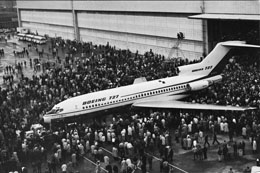On February 9, 1963, the first Boeing 727 Trijet lifts off from Renton Municipal Airport adjacent to Boeing’s Renton plant. The three-man crew consists of chief test pilot S. Lewis "Lew" Wallick Jr., co-pilot Richard Llewellyn "Dix" Loesch, and flight engineer Marvin Keith "Shuly" Shulenberger Jr. It seems all pilots come with nicknames. The two-hour flight ends in celebration at Everett’s Paine Field. Boeing President William M. Allen is quoted as saying, "It flew, it flies, and she looks beautiful" ("727’s Test-Flight ...").
New and Innovative
The distinctive aircraft incorporated an innovative combination of new, if not original, aerodynamic features, including two rear-mounted external engines and a third central engine buried at the root of its T-tail. The jet was the first to have completely powered flight controls and to include an auxiliary power unit to assist takeoff in primitive airports. The tails of early models of the 727 featured a retractable aft passenger stairway rumored to be used to drop supplies and perhaps paratroopers over Vietnam mid-flight.
The 727 was intended to provide service on shorter routes, between 2,500 and 3,000 miles, accommodate shorter runways, and provide fast regional air links for which larger jets and slower prop and turboprop planes were unsuited. The original 727-100 was designed to hold 131 passengers; a 1967 stretch version, the 727-200, accommodated up to 189.
The 727 in Aviation History
While considered a risky step at the time of rollout, Boeing's gamble of $150 million on 727 development paid off. The 727 became hugely popular with orders for a total of 1,832 aircraft through 1984. The last 727 was delivered to Federal Express in September of that year. As of 2023, only a handful remain in service. According to the website Simple Flying.com, a total of 35 727s are still flying, most of them in Africa and Latin America. Many of these serve military purposes.
The 727 in Crime History
Throughout the model’s history, a number of 727s fell victim to crashes, bombings, and hijackings. The 1970s and 1980s were, after all, the heyday of hijacking. There were also unique events, such as the theft of a 727 from an Angolan Airport in 2003, which triggered a global security alert. That plane and the two men aboard have never been found.
On November 15, 1979, a pipe bomb sent by Ted Kaczynski exploded aboard American Airlines Flight 444 from Chicago to Washington D.C. There were no fatalities. The incident led to dubbing the then-unknown terrorist the Unabomber, or University and Airline Bomber.
No doubt the most memorable 727-related event was the November 24, 1971, hijacking of Northwest Orient Airlines flight 305 between Portland and Seattle by a man calling himself Dan Cooper, aka D. B. Cooper. After collecting a ransom, Cooper parachuted from the aft retractable staircase never to be seen again. Following this incident, Boeing modified the staircase so that it could not be deployed mid-air.
As 727s were phased out, many carriers replaced them with the newer Boeing 737. Meanwhile, the prototype 727 was donated to the Museum of Flight by United Airlines, its last owner. After years of work at the Paine Field Restoration Center, the plane made one last flight under a special permit from Everett to Seattle, where it was welcomed to the museum under an arch of water cannons provided by Boeing and King County firetrucks. It is now on display at the museum’s Aviation Pavilion.

